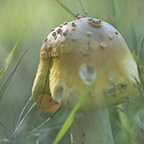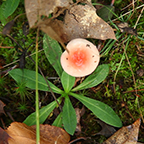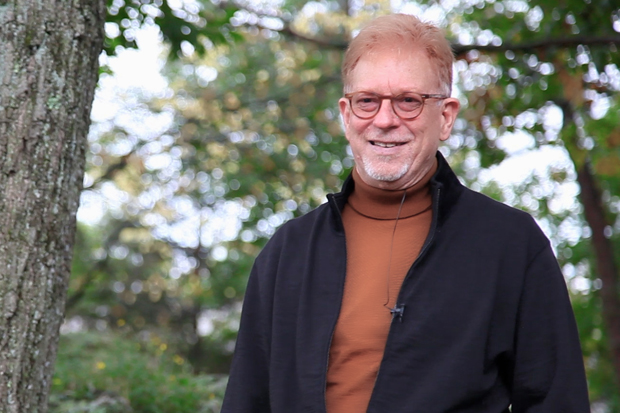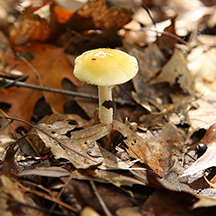The fungus on campus
Take a guided tour of the mushroom patch that was the Brandeis campus this year
It’s the kind of chill, damp fall day that doesn’t hint of snow, but reminds you winter is more a looming reality than a distant memory. On the Brandeis campus, brightening leaves contrast with the gray sky. But Eric Chasalow, dean of the Graduate School of Arts and Sciences and the Irving Fine Professor of Music, has his eyes on the earth.
Chasalow is a renowned composer and performer who has won international acclaim for his works combining traditional instruments with computer-generated sound. But today he is taking a couple of neophytes on a quiet tour of some of Brandeis’ lesser-traveled corners to hunt for fungus – specifically the kind that taste succulent and savory when sautéed in butter (and don’t kill you). It’s been a banner year for wild mushrooms in New England, and finding a kaleidoscope of varieties – edible and inedible – doesn’t take long.

An enthusiastic cook as well as an outdoorsman, Chasalow had always been interested in foraging for mushrooms. After moving to Waltham, he joined the Boston Mycological Club – a mushroom-hunters club that is the oldest such society in the country.
“I wanted to learn and I was nervous about it, because it can be dangerous,” Chasalow says. That year, much like 2018, produced a bumper crop of mushrooms. Chasalow was hooked after his first expedition with the mycological club: the foray netted seven or eight varieties, and he thought that this whole mushroom-gathering thing had to be a lot easier than he’d guessed. “Well no, it was just an amazing year,” he now says.

This year turned out to be quite similar, on the Brandeis campus – Chasalow has seen varieties he never spotted before – and across the region. David Babik, who lives in Natick and is a member of the Boston Mycological Club’s identification committee, explains “this year, we’ve just had the best conditions to make mushrooms fruit.”
A reminder from your intro to biology class: mushrooms are, in fact, the fruiting body of some types of fungi, of which there are a seemingly infinite variety. Fungus sits in its own kingdom apart from animals and plants, and as many as 1.5 million species are estimated to exist, according to the mycologist David Leslie Hawksworth of the Universidad Complutense in Madrid. Underground, fungal threads or hyphae make up the vast network of the mycelium, which grows to absorb nutrients. Mushrooms release spores for reproduction, but they only appear when conditions are right.
“People forget the mushrooms are always there, but they don’t always fruit,” Babik explains.

Eric Chasalow
On this fall morning, with leaves and grass still slick from an overnight downpour, mushrooms spring into view everywhere, once you to look. They pop out through the landscaping near Bernstein-Marcus. Some delicious hen-of-the-woods clumps - grifola frondosa, or maitake in Japanese - cling to tree roots in a few locations that will remain undisclosed. A brown, tan and white marbled variety, ganoderma lucidium (or possibly ganoderma tsugae), some the size of dinner plates, jut from the bases of trees in Fellows Garden. You wouldn't put it in mushroom soup, but in Asia, Chasalow says, it is considered a medicinal with anti-cancer properties.

Near the Spingold theater, the entourage comes upon multiple species and varieties of mushrooms – none of which Chasalow recognizes as edible, but which glow rich chestnuts and purples in the filtered light and the dampness. One radiates white out of a pile of fallen leaves. It’s nearly impossible to take a step and not mash one into the ground. “The thing about fungi is they’re everywhere – you just didn’t notice them,” says Chasalow, recalling that the weekend prior on a trip to western Massachusetts, he spotted some out of the corner of his eye doing 60 mph on the highway.
Chasalow says that he’s been asked about the connection between composing and mushroom hunting – one activity an intensely effortful and deliberate harnessing of creativity, the other relying on luck and harkening back to our origins as food gatherers. He says that walking and seeking help him create a mental space that helps fuel the creativity needed to compose complex works of art. “It’s finding a meditative space and clearing your head and just taking a walk. So if you’re just taking a walk and you’re trying to be meditative, if you find things and it’s a treasure hunt, well that’s a bonus.”
Mushroom-hunting tips:
- Never eat a mushroom that hasn’t been positively identified by someone very experienced as edible. Many edible varieties have poisonous or inedible look-alikes.
- Join a mushroom club and learn what’s safe to eat, where to look for mushrooms and what types appear when.
- Use a basket to store treasures – mushrooms start to decay if they’re kept in plastic.
- Bring a knife – you may need to cut your specimens out of the dirt.
Categories: General





